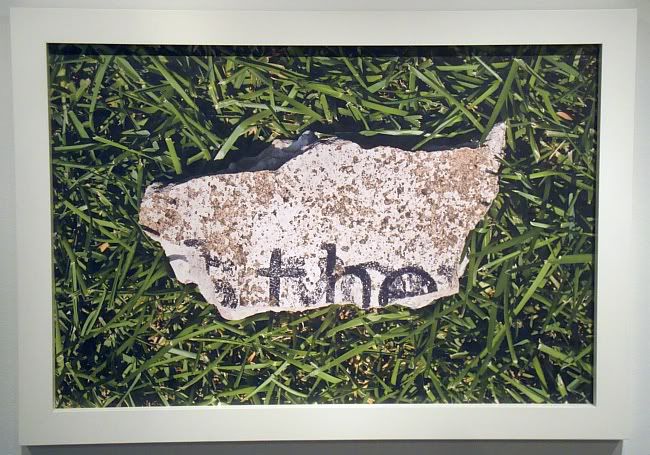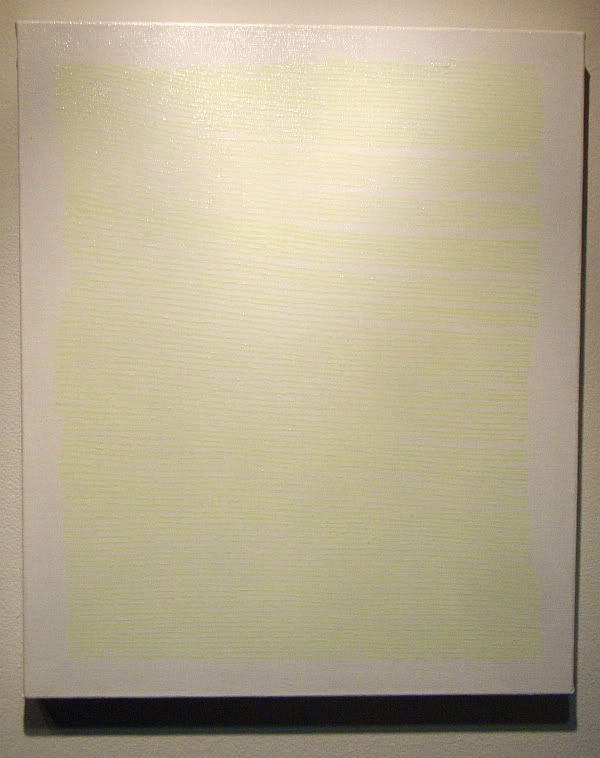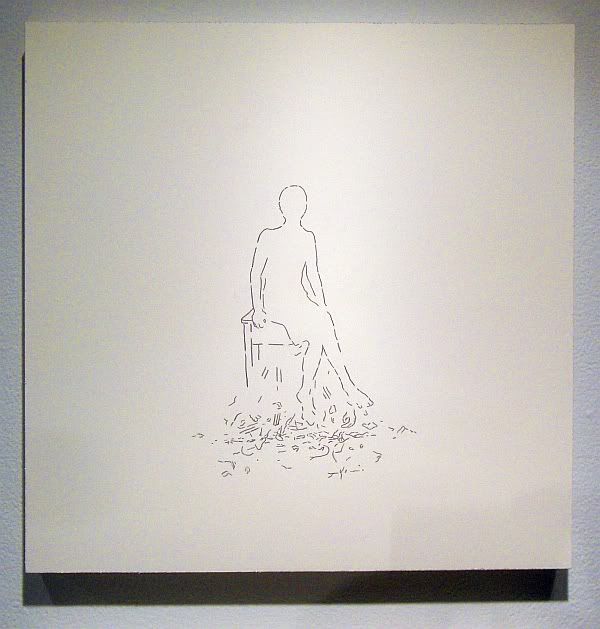In part 1 of this review, I discussed what seemed to me to be the dominant theme of the exhibit--big colorful paintings. But as I said, given the size of the show and the range of work submitted, it was inevitable that there would be variety. But this isn't a thesis-antithesis sort of situation. The work in the show that is not big colorful paintings goes out in all directions. There is sculpture, video, drawing, and mixed media work. There is a lot of quieter work, work in monochromatic shades, work where there is little if any chiaroscuro. This work generally has less of a visual punch (with a few exceptions, as you will see). In general, it's less visceral and more cerebral. In a way, it's almost as if there are three shows happening simultaneously, each with its own merits.
The first piece in the show that really struck me was Casualty in Formality by Britt Ragsdale.

Britt Ragsdale, Casualty in Formality, suits and dress shirts, 2011
This bodiless suit(s) made me think of Charles Ledray's great exhibit at the MFAH. Now here's a weird thing. When I first saw this piece, I thought Britt Ragsdale was a man. I had jumped to this conclusion months earlier because I knew a guy named Britt when I was in high school. It didn't occur to me for a second that "Britt" could be short for, say, "Britney." This incorrect assumption makes a difference. When I saw Ragsdale's sculptures made of women's underwear at the U.H. MFA thesis show, I thought that is was a pretty interesting choice for a man. It seemed highly sexual--like he was saying that this is something he's into. Except "he" wasn't saying that at all. Later I attended a performance by Ragsdale at Skydive--but she was silent and behind a wall, so my illusions were maintained. It was only in a conversation with Sasha Dela a few days ago that I learned the truth.
Does it make a difference whether Ragsdale is a man or a woman? Well, yes. She is making sculptures out of clothing that is defined as "women's clothes" or "men's clothes." One's relationship to these clothes is likely to be different for men than for women.
A simple reading of Casualty in Formality is that it is a visualization of the old cliche "clothes make the man." But the position--prone and bisected--makes us think about that word "casualty" more. Men rarely wear suits anymore, except in certain professions. My dad put on a suit and tie every morning to go work in an office very similar to the one I now work in. If I showed up in a suit and tie, my coworkers would think I had a job interview. In my company of several thousand workers (hundreds of whom work in our offices), only the CEO regularly wears a suit to work, and his sartorial choices are considered a sign of eccentricity. So she might be talking about the death of that kind of everyday formality.
But what I like about it is that it is a mysterious object (or pair of objects). It's set low to the ground; it's made of cloth--in short, it is quite unlike traditional sculpture. Furthermore, it is made out of the thing it depicts! I like that self-referentiality.
Ragsdale also had a video in the show (one of two videos). You can see it below.
DUET from Britt Ragsdale on Vimeo. 2010
I liked Duet as well. The man appears to be whispering something into the woman's ear. She seems to like what she hears (based on her happy expression), but her expression never changes. Their eyes blink and we can see small bodily motions, but otherwise the pair seem frozen.It's almost like they are posing for a double portrait. And this video is, in fact, a double-portrait. I'm sure some people walking by on opening night didn't even notice that it was a video. So it plays with the tension between video (a medium that implies time and motion) and still portraiture.
Another recent UH MFA who had good work in the Big Show is Emily Peacock. Her pieces were among the relatively few photographs in the exhibit.

Emily Peacock, Family Portrait, C-print, 2010
When I look at Peacock's work, I feel like I am looking at a snapshot with at least one very weird thing going on. With Family Portrait, we have the blurred falling cat (or dog?). I won't say these strange features undermine the quotidian nature of the snapshots as much as they force us to concentrate on the usually invisible qualities of casual family snapshots. It's easy for our eyes to pass over a snapshot like this lightly. But add a blurred falling cat to the photo, and we're forced to linger.

Brain Campbell, I can't believe I'm doing this, digital photograph, 2011
Brian Campbell's photos in the Big Show also have an underlying strangeness to them.What exactly are we looking at here? Is this a photo of a person or a doll--or is a doll's face superimposed onto a woman's body? The title implies an emotional response to a situation--regret, possibly, or shame--that is belied by the wide-eyed expressionlessness of the face.
Like Britt Ragsdale, J.E. Theriot has two pieces in the show in two different media, sculpture and photography. The sculpture, Spraying Hands, is an image painted on a concrete block. the photo, Concrete The, is a photo of a word painted on a concrete block.

J.E. Theriot, Concrete The, photographic print on PVC, 2009
The "the" is cut off. It looks like it was typed with a manual typewriter, and we can see some ghost type underneath it. The word "concrete" in this context makes me think of "concrete poetry," poetry where the lines varied in length to create an image. It was a merging of visual art and poetry. (It had its heyday in the 1950s and 60s.) Aside from this, though, I see it as an interesting, enigmatic image.
There are plenty of painters in this "other" Big Show, but they distinguish themselves by their restraint, eschewing bright colors and aggressive compositions. Matt Messinger does have one similarity with some of the other painters I discussed in the previous Big Show post--he draws from the world of comics and cartoons.

Matt Messinger, 1928 (Popeye), found linen, gesso, black gesso, 1928 receipt and charcoal, 2011
His drawings remind me of model sheets--drawings of a cartoon character in different poses from different angles that were used by animators to make sure the character looked right as they were animating him.One could imagine this as the blotter of a Fleischer Studios animator--receipts, little drawings, notes to himself.

Matt Messinger, Whitestar Line (Heckle and Jeckle), Found linen, gesso, black gesso, pencil and charcoal, 2011
Messinger had three pieces in the show, each excellent. As I have said before about his work, his use of old cartoon/comic strip characters doesn't feel forced. I feel like he is evoking a working class nostalgia. Even his damaged, roughly gessoed canvases play into this--they look like whitewashed billboards and bleached-out hand-bills. The nostalgia evoked is not that of the nostalgia industry--the slick, licensed Betty Boop merchandise, for example. No, I would compare it to Cy Twombly, whose work likewise evokes old walls that have been covered repeatedly with graffiti. It is Twombly (and Paul Terry and E.C. Segar and Max Fleischer) I think of when I see Matt Messinger's work.

John Sturtevant, Almost There, acrylic on canvas, 2011
I want to apologize for this photo. The problem here is that the work is very subtle--parallel wavy yellow lines, with an extremely narrow range of values. It's an inherently difficult painting to photograph, and when you combine that fact with my terrible photography skills and cheap camera, this is what you get. I especially want to beg your indulgence here because I thought Sturtevant's paintings were two of the most interesting in the show.

John Sturtevant, Almost There (detail), acrylic on canvas, 2011
I'm afraid I'm quite fond of pale, difficult to photograph paintings and drawings.

Loli Fernandez, Zu Lang (Too Long)..., silverpoint on board quadtych, 2011
This pale drawing by Loli Fernandez looks like a biological illustration form the 19th century--perhaps one that has faded over time. It has a squishy, haunting beauty. My photo does it little justice--go see it in person. It is part of a four-drawing suite.

Dran Alessi, Pieces, pencil on paper/board, 2011
Dran Alessi is (as far as I can determine) a physician. That's one thing I like about the Big Show--it brings out the Sunday painters, artists who do something as their profession and also do art. I can relate--I work for and energy company and do this blog in my spare time. I love amateurs, especially when they produce work this good. I like the spare drawing style, and the details left out. Her broken lines remind me of those of the cartoonist R.O. Blechman. The empty space inside the outline of the figure is a an intriguing emptiness, and the marks below the figure look as if they could be all the details that would particularize the figure, fallen out and piled on the floor.

Jimmy Houston, Whimper, acrylic on panel, 2011
Jimmy Houston's two pieces in this show are monochrome stumblebum robots--very unlike the sleek robots of most science fiction. Houston has a great illustrational style and real humor in his work. But what is really weird is that he wasn't the only guy drawing monochromatic robots in the show.

Rodney Flores, Safe Place, pen and ink and colored pencil on butcher paper, 2011
If Houston's robot is post-bender, Rodney Flores is mid-bender. (I suppose both these guys are cousins to Bender, the alcoholic robot from Futurama.) The title is accurate and ironic--for some, booze is a refuge. I like Flores' use of the colored ground (the butcher paper) with the dark pencil and white pencil to add value, form and texture.

Catherine Winkler Rayroud, The Master of the Universe, papercutting made with scissors and scalpel, 2011
Another artist who uses humor in her work is Catherine Winkler Rayroud. She was also in last year's show.In those pieces, she cut silhouettes of lace underwear (a bra and panties) where the lace formed ironic images. With Master of the Universe, she is more straightforward. I saw this piece and thought of my brother-in-law, an avid motorcyclist. He's a successful upper-middle-class executive who likes to ride on the weekend with his buddies.This guy, as depicted by Winkler, in no way makes you think of someone powerful or rich. But the title reflects how he feels when he gets on his bike.
Britt Ragsdale's Casualty in Formalitywasn't the only sculpture in the show. In part three of this review, I'll discuss a few more sculptural objects. Whew--the Big Show is really demanding on a writer.




No comments:
Post a Comment